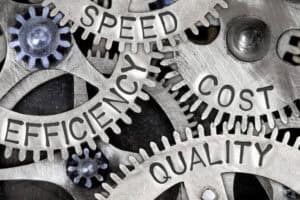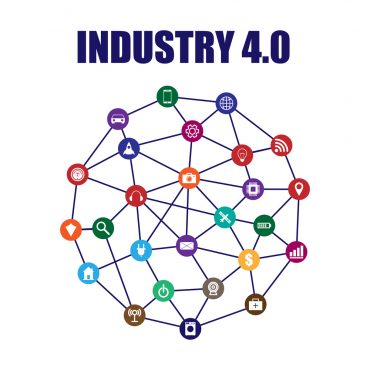
A modern approach to industrial connectivity, one that is not simply a one-to-one sharing of data between point systems, enables IT/OT convergence. That, in turn, allows manufacturers to operate more efficiently, innovate continuously, and respond swiftly to changing market dynamics.
Industrial connectivity allows manufacturers to bring together IT and operational technology (OT) data, applications, and systems that have traditionally been siloed. Once the obstacles of proprietary protocols and formats are removed, manufacturers can realize a number of operational and economic benefits from IT/OT convergence.
Not your parents’ industrial connectivity
Industrial connectivity has been around for a long time – since the start of Industry 3.0 and automation. It has been used to get data from machines or several different systems to drive efficiency.
However, when implemented, it was typically used for point-to-point integrations, e.g., connecting one machine to a human-machine interface (HMI). It was never deployed strategically to collect vast amounts of data, aggregate it, and serve it up to other OT and IT systems.
The acceleration of digital transformation in manufacturing and the growing adoption of IIoT and advanced analytics have created great demand for OT data. As a result, more and more manufacturers are leveraging industrial connectivity deployed at scale across their entire operations.
So, with modern industrial connectivity, there is a move towards standardization, where manufacturers are trying to think more holistically about architecture and scale because they’re going to look at this data within a site and across multiple sites as well. The standardization aids in scalability, reducing administrative burden, and reducing cybersecurity risks.
To that point, industrial connectivity breaks down the OT silos across a company and allows data, regardless of the source format, to be accessed. That data can then be unified with IT systems data.
So, data is no longer locked in or held exclusively in to one functional business applications or assets. Instead, IT and OT data is brought together allowing for entirely new digital processes to be developed.
Once such data is available, manufacturers are able to create applications that turn that data into actionable insights. These applications may be developed to support use cases such as performance management of a plant, asset improvements, utilizations, and maintenance.
As such, industrial connectivity is a key foundational ingredient of IT/OT convergence in that it unlocks the opportunity to innovate new processes and develop new applications that are not locked into the legacy data environment.
See also: How Industrial Connectivity Enables Manufacturing Automation and Insights
IT/OT convergence benefits
Some of the common areas where IT/OT convergence helps include:
Enhanced Operational Efficiency: Manufacturers can make use of the shared data to improve:
- Data-Driven Decision Making: Real-time data from OT systems can be integrated with IT analytics to optimize production processes, reduce downtime, and improve overall efficiency.
- Predictive Maintenance: Combining IT and OT data enables predictive maintenance, reducing unplanned outages and extending equipment lifespan.
- Automated Processes: Automation can be more effectively implemented and monitored, leading to increased productivity and reduced human error.
Cost Savings: Going hand-in-hand with improving operational efficiency, IT/OT convergence provides the data and insights to cut costs. That includes:
- Improving Energy Efficiency: Integrating IT and OT can identify energy inefficiencies and optimize energy use, leading to significant cost savings.
- Reducing Maintenance Costs: Predictive and condition-based maintenance strategies lower the costs associated with reactive maintenance.
Improved Product Quality: Having easy access to data from IT and OT systems offers a number of ways to address product quality. They include:
- Quality Control: Real-time monitoring and analytics can detect defects or inconsistencies early in the production process, ensuring higher quality products.
- Process Optimization: Continuous feedback loops between IT and OT systems help in fine-tuning processes to maintain consistent product quality.
Secondary benefits abound
The items above are the direct manufacturing process benefits that IT/OT convergence helps with. However, once the data is available, many more use cases and applications are possible. These other application areas deliver organizational benefits, including:
Manufacturers are under great pressure to respond quickly to market changes as they occur. A startup may include new technology forcing traditional players in a market to play catchup to satisfy customer demand. A regulatory change might force a rethink of sustainability or security strategies. Some areas where IT/OT convergence can help include:
Increased Flexibility and Agility:
- Enabling Rapid Response to Market Changes: IT/OT convergence allows manufacturers to quickly adapt to changes in demand, supply chain disruptions, and new market opportunities.
- Customizable Production: Enhanced data integration supports more flexible manufacturing processes, enabling mass customization and quick shifts in production lines.
Enhanced Security:
- Unified Security Measures: A converged IT/OT environment allows for a holistic approach to cybersecurity, addressing vulnerabilities across both domains.
- Improved Incident Response: Integrated systems enable faster detection and response to security incidents, minimizing potential damage.
Innovation:
- New Business Models: The integration of IT and OT can support the development of new business models, such as selling services rather than products and outcome-based contracts.
- Technological Advancements: Embracing technologies like IoT, AI, and machine learning within a converged IT/OT framework drives innovation and helps maintain a competitive edge.
Regulatory Compliance:
- Improved Reporting: Converged systems facilitate better data collection and reporting, ensuring compliance with industry regulations and standards.
- Traceability: Enhanced traceability of materials and processes helps in meeting regulatory requirements and managing recalls more effectively.
A final word on modern industrial connectivity for IT/OT convergence
Overall, IT/OT convergence allows industrial manufacturers to operate more efficiently, innovate continuously, and respond swiftly to changing market dynamics while maintaining high standards of quality and security. A modern approach to industrial connectivity, one that is not simply a one-to-one sharing of data, ensures data can be easily shared and made available to power new applications and services.








